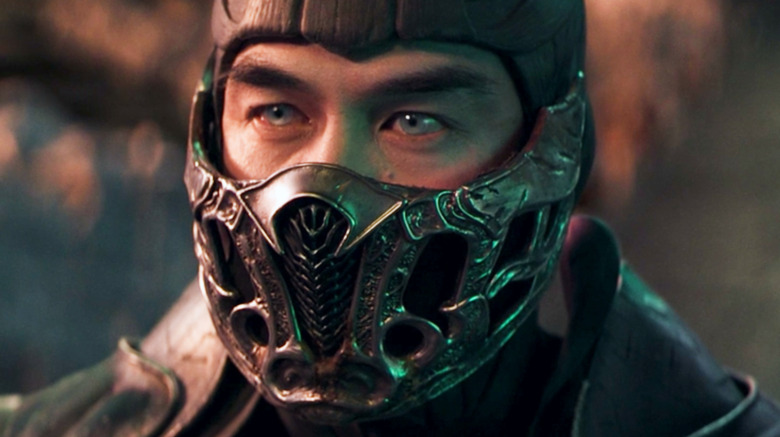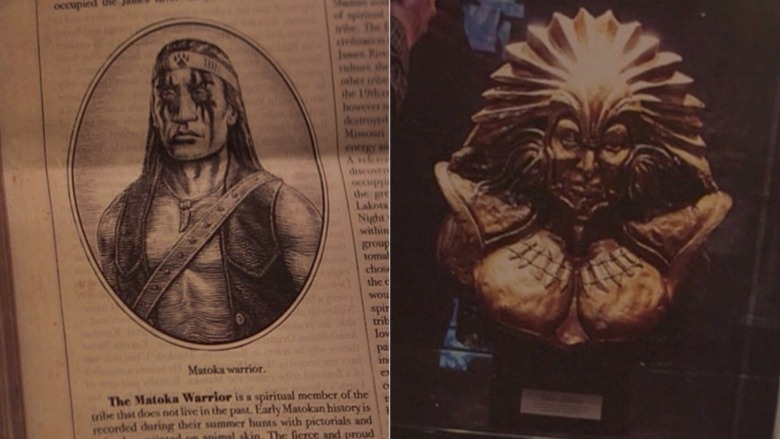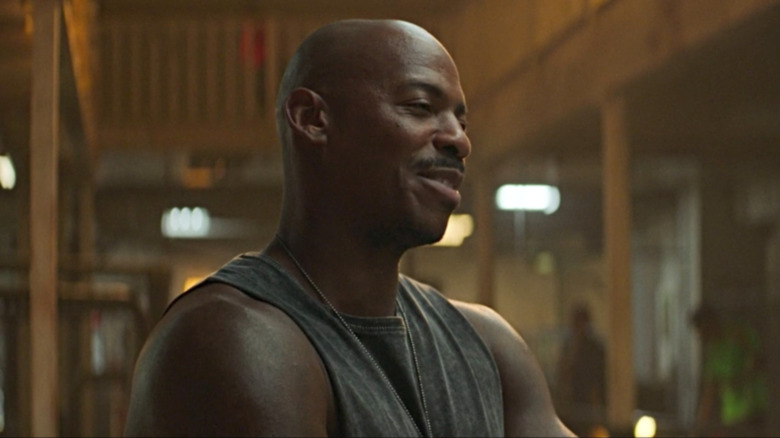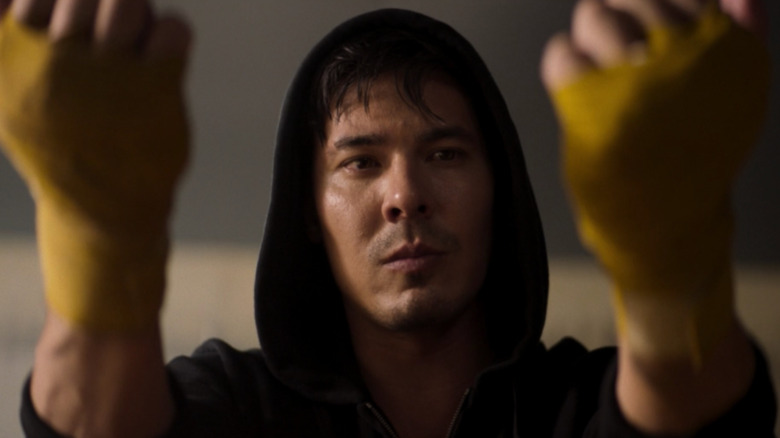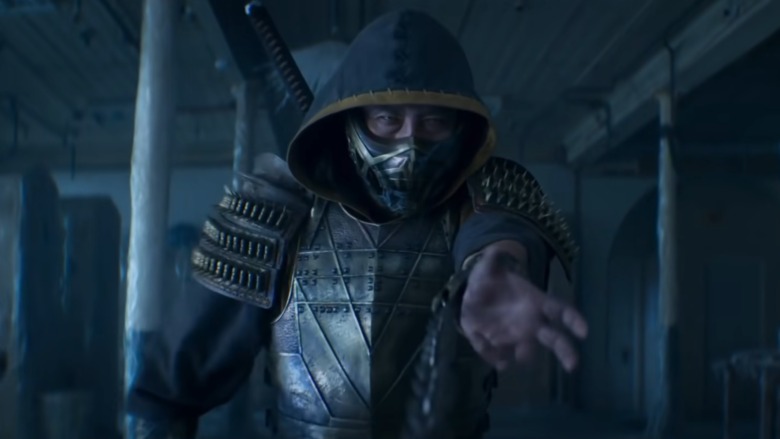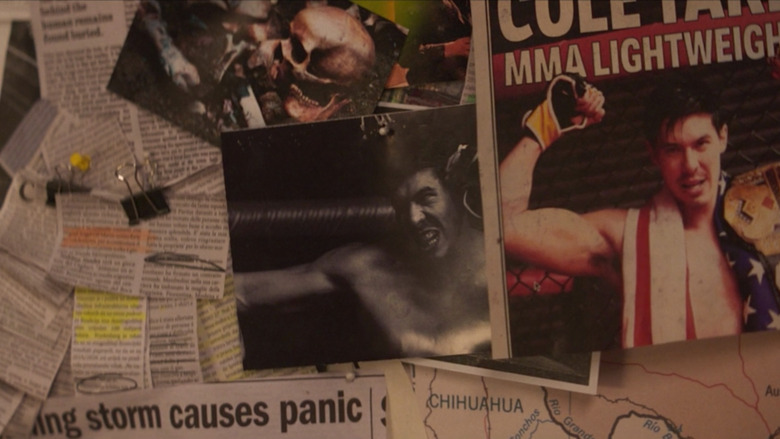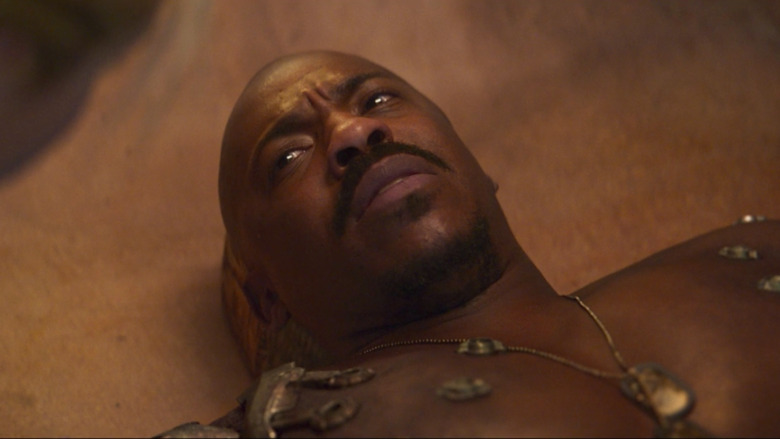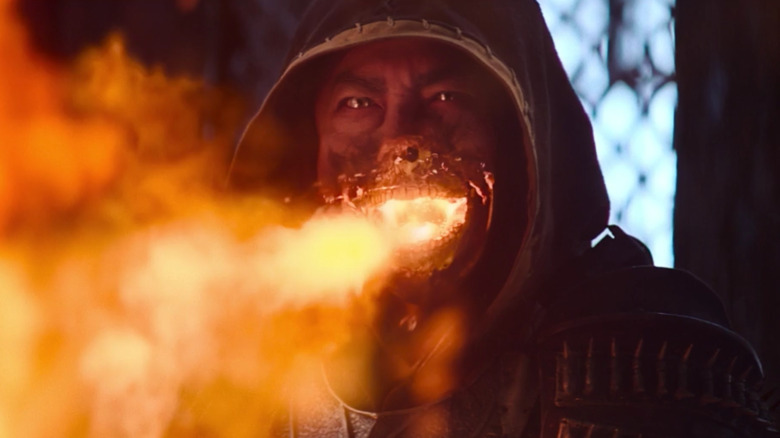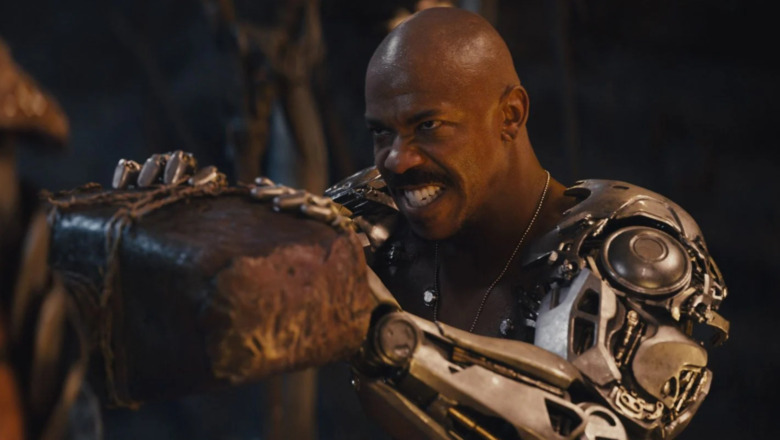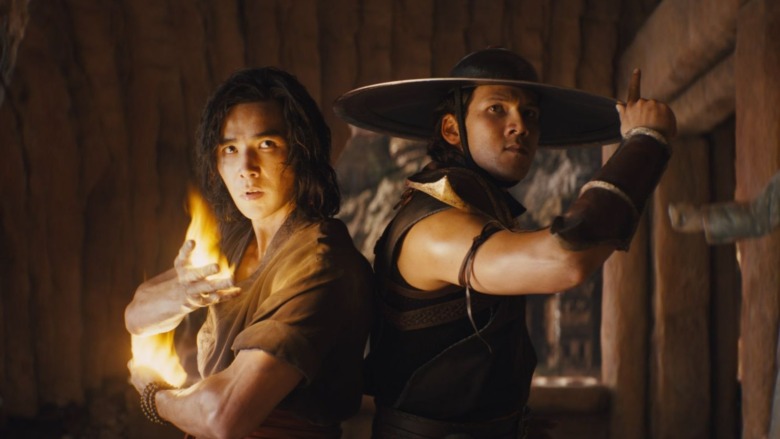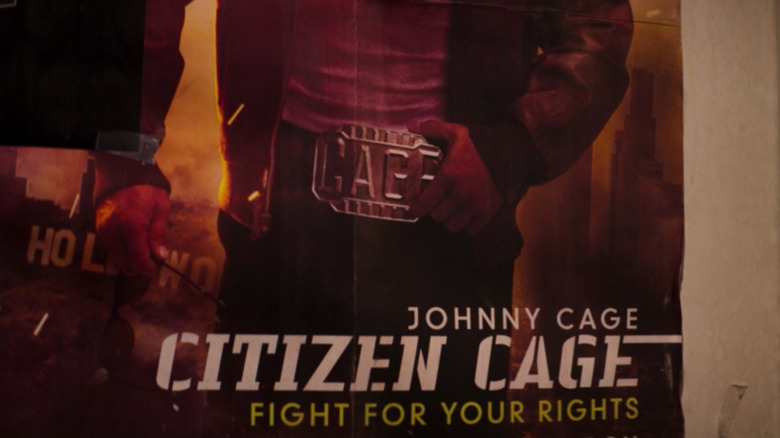Easter Eggs You Missed In Mortal Kombat
Contains major spoilers for "Mortal Kombat"
The hotly anticipated live-action "Mortal Kombat" movie is finally out in theaters and on HBO Max, and it's ready to grab audiences by the throat. No matter how you feel about the previous attempts to bring all the bloody thrills of the video game series to life, this latest version makes its own mark by introducing new characters into the fray, keeping the fights brutal and gory, and including more Easter eggs and hidden details than you can shake a freshly disembodied spine at.
From nods to characters who weren't included in the film to loving tributes to the developers of the original game series, 2021's "Mortal Kombat" feels distinctly like it was made by fans, for fans. There's a lot going on in this movie — so much so that even those who remember dropping quarters in the original arcade console are likely to miss a detail or two. But don't worry: We've scoured the movie for references, callbacks, and other small details in order to help make your viewing experience a flawless victory.
Here are the Easter eggs you may have missed in "Mortal Kombat."
More characters from the game than meets the eye
From series standbys like Liu Kang (Ludi Lin) and Sonya Blade (Jessica McNamee) to more obscure fighters such as Nitara (Mel Jarnson) and Reiko (Nathan Jones), "Mortal Kombat" manages to incorporate a wide array of characters from the game series. And that's only to mention those who actually appear in the film. If you pay close attention, you'll notice that even more characters get referenced throughout the movie, even though they aren't seen on screen.
Early in the film, Sonya is showing Cole Young (Lewis Tan) her research on the Mortal Kombat tournament and Outworld. One of the documents is a page from a book that includes an illustration of a Native American man with the caption "Matoka warrior." The person in the illustration looks remarkably like Nightwolf, a fighter introduced in "Mortal Kombat 3" who's a member of the fictional Matoka tribe. Sonya's research also includes an image of what appears to be an Aztec bust, which could be a nod to Kotal Kahn. "Mortal Kombat X" introduced the intimidating character whose design draws some obvious inspiration from Aztec culture.
Elsewhere in the movie, characters namedrop Shao Kahn, the brutal Emperor of Outworld, as well as Bo' Rai Cho, the martial arts grandmaster who trained Liu Kang. Raiden's temple also contains a couple of visual nods to unseen characters. The signature fan blades of the Edenian Princess Kitana can be seen displayed in one of the temple's corridors, and one crucial scene sees Kano stealing an item that looks very similar to the Amulet of Shinnok. The appropriately named magical talisman in question belongs to Shinnok, an elder god who first appeared in "Mortal Kombat 4."
Nods to Mortal Kombat's creators
Not only does the "Mortal Kombat" movie make numerous references to characters who don't even appear in the film, but it also manages to push things even further by paying homage to the series' creators.
We get our first taste of this when Jax introduces himself to Cole Young. Jax mentions a past fight where Cole managed to take the belt away from a fighter named "Eddie Tobias," a subtle nod to "Mortal Kombat" co-creators Ed Boon and John Tobias, who was the main character designer for the franchise until "Mortal Kombat 4." Tobias is also responsible for much of the lore and world-building of the early games, and is even known to share on his Twitter page some behind-the-scenes details and fun facts about the games.
Additionally, the movie honors the "Mortal Kombat" franchise's real home: Chicago. When Cole's relation to Scorpion is revealed, the protagonist finds it hard to believe, as he considers himself just a kid from the Southside of Chicago. The Windy City was the home of original "Mortal Kombat" developer Midway Games, which was also responsible for other arcade hits like "Rampage" and "NBA Jam." As noted in "Insert Coin," a documentary on the now-defunct studio, Midway Games filed for bankruptcy in 2009; Warner Bros. bought the "Mortal Kombat" IP that same year. And yet, Chicago can still claim "Mortal Kombat" because NetherRealm Studios, the studio responsible for the current crop of "Mortal Kombat" games, is currently based in the city. Talk about a full-circle moment.
Clothes are the ultimate clue
Colors play a huge role in "Mortal Kombat," especially the older games in the series. Much of the ninja characters like Scorpion, Sub-Zero, and Rain were different from each other visually thanks to the primary colors used in their design. It only makes sense for the new movie to play around with this concept in its own unique way.
When we're first introduced to Cole Young, he's seen prepping his hands for a MMA fight, wrapping them yellow tape. This is a reference to Scorpion and his clan, the Shirai Ryu, whose main color is yellow. It's also an early hint that Cole is somehow related to the clan and Scorpion. There's even a spot of yellow on the strap of his gym bag.
Not to be outdone by his rival, Sub-Zero also provides us with a major visual clue that hints at his ultimate fate. During his final battle with Scorpion and Cole, the ice-cold assassin gets rid of the blue parts of his outfit showing himself in complete black — a reference to the super-dark Noob Saibot, a character that the first Sub-Zero, Bi-Han, later becomes after being killed by Scorpion in the games.
Noob Saibot is a play on the names of "Mortal Kombat" co-creators Ed Boon and John Tobias: "Boon" backwards is "Noob," and "Tobias" backwards is "Saibot." The character was introduced in the series, thanks to Boon, in "Mortal Kombat II." However, Noob Saibot was so secret a character that not even Boon's partner Tobias knew about him at first. As Tobias revealed to Polygon, he was already a few months into development on "Mortal Kombat 3" before he even learned about the secret character's existence.
Mortal Kombat theme moments
The "Mortal Kombat" movie wouldn't be considered authentic without the iconic techno theme that has become associated with the series. Fortunately, there are two scenes in the new film where bits of it can be heard. When Liu Kang launches his trademark bicycle kick against Kabal, a few familiar notes play in the background. It's subtle, especially compared to when the theme makes its second appearance during the film's conclusive stretch. When Scorpion finally appears to face Sub-Zero in their ensuing battle, the theme returns — this time booming in a cool remix.
The "Mortal Kombat Theme" is officially called "Techno Syndrome," created by Belgian duo the Immortals, aka Maurice "Praga Khan" Engelen and Oliver Adams. The two are also known for their work from the group Lords Of Acid. As detailed by Vulture, "Mortal Kombat" developer Midway Games contacted Engelen and Adams about making an album to go along with the 1994 home console release of the hit arcade game. While between tours, the two got to work producing the entire album within four weeks.
"Mortal Kombat: The Album" featured songs based on the original roster of characters in the first game, but it was "Techno Syndrome" that became the defining hit, going on to be used in commercials, movies, and just about anything the series has dipped its brutal hands in. For the soundtrack of 2021's "Mortal Kombat," composer Benjamin Wallfisch gave the theme a new EDM-tinged feel.
Sonya's wall of research has even more hidden details
Early on in the film, Sonya fills Cole in on the legend of the Mortal Kombat tournament by showing him her collection of newspaper clippings and other research materials. We've already touched on the character references that appear during this moment, but there are also a few other interesting things that can be found on her wall.
One obscured headline reads "—ning storm causes panic." Although the first word is mostly cut away, it seems possible that the whole phrase is meant to read "lightning storm causes panic." Considering it's on Sonya's wall of research, that could be a reference to Lord Raiden (Tadanobu Asano), who arrives in Earthrealm via an intense series of lightning strikes on multiple occasions. The headline could be describing what Raiden's strikes looked like to normal Earth-dwellers who were unaware that they were witnessing the approach of the God of Thunder.
Similarly, another incomplete headline reads "— breaking hailstorm." Presuming it's meant to say "record-breaking hailstorm," that could be a reference to Sub-Zero. Earlier in the movie, he arrived in Earthrealm and manifested a fierce ice storm while attempting to kill Cole. Could he have done something similar at another time, leading to people confusing his supernatural powers for an extra intense weather event? It's possible.
This is the new canon ... for now
"Mortal Kombat" is a game series that isn't afraid to make changes to its own canon. For instance, "Mortal Kombat 9" was a reboot for the series, and made some key changes in the stories for the first three "Mortal Kombat” games. The new "Mortal Kombat" movie is just as happy to play around with established lore — whether it be Kano teaming up with the heroes, or introducing a completely new protagonist to the fold.
But things get a little ridiculous when it comes to Jax and how he loses his arms. Sub-Zero is the one to take away Jax's human arms in the new movie — but, as a Den of Geek article on the character points out, this is only the latest in a variety of unfortunate ways Jax has lost his arms in the game series. In "Mortal Kombat 9," Jax has his arms exploded when Ermac uses his telekinetic powers. In the web series "Mortal Kombat: Legacy," grenades destroy Jax's arms. And in the animated "Mortal Kombat Legends: Scorpion's Revenge," Goro just completely rips them off.
Let's hope that the next retelling of how Jax loses his arms is kinder to the Special Forces Soldier.
Did you catch all the recreated game fatalities?
"Mortal Kombat" more than earns its R rating thanks to the graphic fatalities that conclude many of the brawls in the movie. In fact, the film actually recreates several of the iconic finishing moves from the game franchise.
Early in the movie, an encounter between Kano and Reptile ends with Kano reaching into the creature's chest and ripping out its heart. That same move was used as Kano's fatality in the very first "Mortal Kombat" game. Similarly, the fire-breathing finisher that Hanzo Hasashi, aka Scorpion (Hiroyuki Sanada), pulls on Bi-Han, aka Sub-Zero (Joe Taslim, is a throwback to the original game.
Two of the movie's goriest moments also come directly from the games. Kung Lao's (Max Huang) hat is the butt of quite a few jokes throughout the film, but he proves its brutal utility when he quickly ends an encounter with the winged Nitara (Mel Jarnson) by turning the bladed headwear into a buzz saw and feeding her into it. A version of this particularly gruesome fatality was first used in the spin-off game "Mortal Kombat: Shaolin Monks," and has gone on to become a mainstay of Kung Lao's repertoire in the main series.
Meanwhile, Jax (Mehcad Brooks) gets the chance to test out his new arcana-powered metal arms while fighting Reiko. After beating Shang Tsung's (Chin Han) lackey to his knees, Jax claps his hands on Reiko's head, bursting it like a melon. This move was one of Jax's first fatalities when the character made his debut in "Mortal Kombat II."
Liu Kang gets an opportunity to show off his impressive arcana power as well. After subduing Kabal (Daniel Nelson), Liu summons from the ground a dragon made of fire. The fiery creature bites Kabal, lighting him on fire and ultimately burning him to death. This is a variation of Liu Kang's dragon transformation fatality that he first started using in the franchise's second installment.
Specific nods to the video games
Longtime fans of the franchise are no doubt going to be thrilled that "Mortal Kombat" is full of small references to the particulars of the video games. Take, for instance, Kung Lao's words of encouragement to Cole and Kano when they begin their training: "All you can do now is test your might." This is a nod to the first game in the series, which featured a mini-game called "Test Your Might." It tasked players with mashing buttons to make their characters chop through piles of material ranging from planks of wood to a block of pure diamond.
The filmmakers also managed to incorporate other bits of now-iconic dialogue players would regularly hear from the game's announcer at the end of matches. Several of the fight scenes in the movie conclude with the characters saying things like "flawless victory" and "fatality." After he defeats Reptile, Kano even giddily announces, "Kano wins."
These references aren't just relegated to dialogue. The set design of "Mortal Kombat" draws some inspiration from the levels of the games, specifically the iconic stage known as the Pit. There have been several versions of this arena throughout the franchise, but the basic gist is always the same: the Kombatants fight on a bridge overlooking a pit of razor-sharp spikes. A version of this concept appears late in the movie when Jax squares off against Reiko.
Mortal Kombat pays tribute to uppercuts and leg-sweep spammers
Fatalities aren't the only moves from the "Mortal Kombat" games that pop up in the film. Cole's spirited daughter Emily (Matilda Kimber) frequently tells her father to use an uppercut during his fights, a punch that has been ubiquitous for nearly every character in the series starting with the first game. During a 2016 interview with Game Informer, series co-creator Ed Boon even said that nailing the uppercut was integral in the development of the first game. He recalled, "The big thing was this uppercut. Once we got this uppercut going ... suddenly everybody is coming into my office 'Aw, let me see the game!'"
Another frequently used maneuver from the original games that got a special callout in the movie is the leg sweep. In what appears to be a nod to players who love to spam the move in order to score an easy victory, Liu Kang leg-sweeps Kano several times during one of their training sessions. After Kano successfully hops over one of the sweeps, Liu Kang then fakes him out before getting him with another one. This will no doubt feel familiar to anyone who has thrown their controller in frustration because their friend wouldn't stop using the move.
And, of course, many of the characters get a chance to show off their special abilities. Liu Kang gets his fireballs, Kano has his laser eye, and even Sonya's pink energy rings make an appearance.
Johnny Cage indeed exists in the Mortal Kombat movie universe
When the characters got revealed for the latest "Mortal Kombat" movie, we had one burning question: Where the heck is Johnny Cage? "Mortal Kombat" producer Todd Garner told SyFy Wire that the character wouldn't appear in the film, but gave hope of his appearance in a potential sequel. And now, a huge Easter Egg for the character has ignited our hopes for Cage's return to the big screen hotter than Scorpion's fire-breathing fatality.
The movie ends with Shang Tsung's evil crew defeated (for the time being), but Raiden has requested that our heroes seek out new defenders for Earthrealm. As Cole leaves his MMA gym on this mission from the Thunder God, he reveals that his search is taking him to Hollywood. We then get an image of a poster for a movie called "Citizen Cage," starring actor-turned-Kombatant Johnny Cage.
Johnny Cage is a staple character for the game series, and even shares the spotlight with his daughter Cassie Cage in "Mortal Kombat X" and "Mortal Kombat 11." With such a big personality and his trademark split punch, Johnny is, unsurprisingly, modeled after a real Hollywood action star: Jean-Claude Van Damme. The minds behind the IP wanted Van Damme to be in what eventually became "Mortal Kombat," but he wasn't keen on it. Thus, Ed Boon and John Tobias forged ahead, the JVCD project turned into "Mortal Kombat," and Johnny Cage was born.
